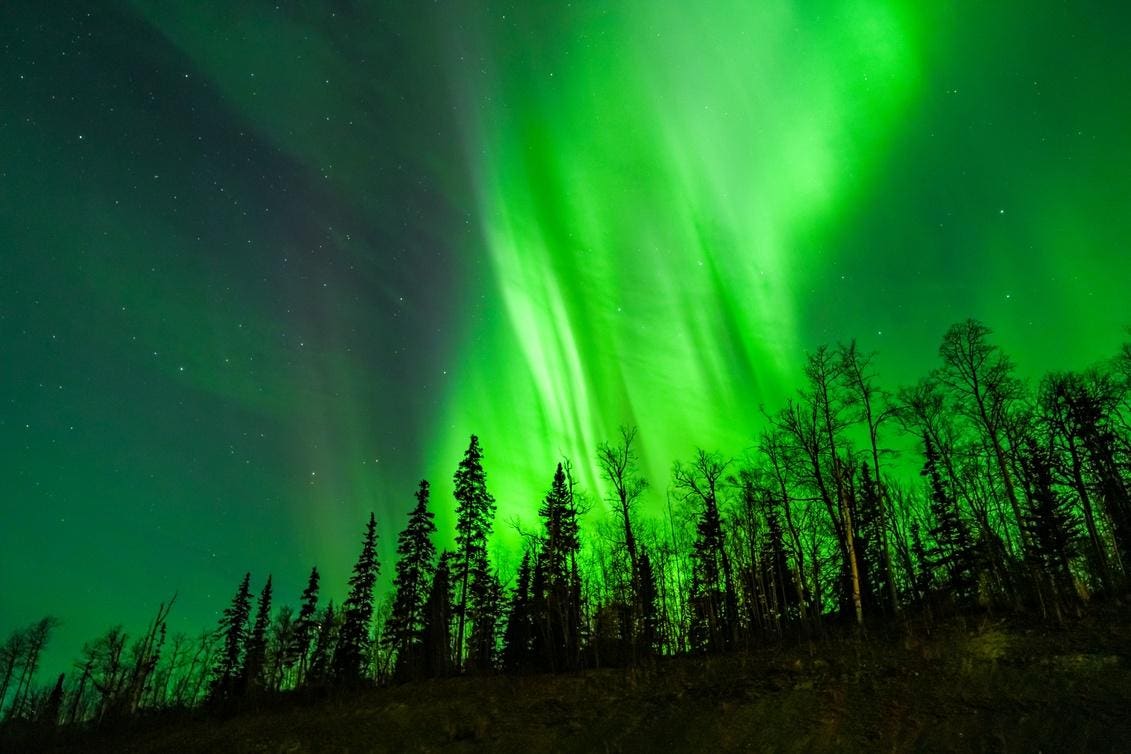
ALASKA, UNITED STATES – SEPTEMBER 30: Intense northern lights (aurora borealis) above Kp5 were observed in Alaska’s Matanuska-Susitna Borough, around Chickaloon and Bonnie Lake, on the night of September 30 to October 01, 2025. The aurora created a breathtaking scene, illuminating the snow-capped peaks of the mountains surrounding the Matanuska Valley and their reflections on Bonnie Lake. (Photo by Hasan Akbas/Anadolu via Getty Images)
Anadolu via Getty Images
The Northern Lights may be visible in the U.S. this weekend, according to a forecast by the National Oceanic and Atmospheric Administration’s Space Weather Prediction Center.
Sky-watchers in 12 U.S. states may have a chance to see the aurora borealis on the northern horizon as soon as it gets dark.
Although the agency’s three-day forecast does not indicate a geomagnetic storm, there have been heightened levels of geomagnetic activity all week as Earth moves through a high-speed stream of solar wind.
ForbesNorthern Lights Alert: Sudden Auroras In U.S. May Persist This WeekBy Jamie CarterLast Chance For ‘Equinox Auroras’
It’s been a busy week for the Northern Lights. “These are the last gasps of an occasionally strong 5-day geomagnetic storm that produced magnificent auroras around the Arctic Circle and about a dozen US states between Sept. 28th and Oct. 2nd,” according to Spaceweather.com.
According to NOAA’s forecast, the Kp index — which provides a rough guide to the intensity of aurora displays — may reach 4. According to NOAA, expect “primarily unsettled to active conditions persisting through 05 Oct.”
The root cause of all; of this unpredicted activity? Autumn equinox on Sept. 22. The Northern Lights occur when charged particles from the sun accelerate down Earth’s magnetic field lines and collide with molecules high in Earth’s atmosphere. However, it’s magnetism that makes it all work — and it changes dramatically around the equinoxes in March and September.
NOAA’s aurora viewline for Friday, October 3, 2025.
NOAAWhere The Northern Lights May Be Visible
NOAA’s latest aurora viewlines indicate that aurora displays are a possibility in northern U.S. states and Canada, with 12 U.S. states having a chance after dark on Friday, Oct. 3 and potentially through the weekend — though the imminent full harvest moon may make the aurora slightly harder to see.
U.S. states that may see aurora include Alaska and (northerly parts of) Washington, Idaho, Montana, Wyoming, North Dakota, South Dakota, Minnesota, Wisconsin, Michigan, New York and Maine. Dark northern skies away from urban light pollution are likely to offer the best views.
ForbesNorthern Lights Alert: Why Aurora Could Now Suddenly SpikeBy Jamie CarterWhat Is An ‘Equinox Aurora?’
Geomagnetic storms can become particularly intense in the weeks surrounding the equinox because the magnetic field of Earth and the solar wind align. The phenomenon is known as the “Russell-McPherron Effect” as per a paper in 1973.
The sun and Earth’s magnetic fields are lined up with their equators, but since Earth rotates on a tilted axis, they are not aligned. Twice a year, near the equinoxes, the south-pointing part of the sun’s magnetic field more easily connects with Earth’s magnetic field. When that happens, charged particles from the sun penetrate Earth’s defenses more easily, driving more (and more intense) geomagnetic storms and auroras.
Latest Aurora Forecast Tonight
Check NOAA’s 30-minute forecast or use the Glendale Aurora and My Aurora Forecast apps. Although the Kp index is important — as is whether a geomagnetic storm commences — what’s typically decisive in the formation of aurora is the direction of the interplanetary magnetic field (Bz). It’s only when the Bz is south that active auroras are seen. Data about the Bz direction can be seen easily on websites like SpaceWeatherLive.com and Aurora Forecast.
Wishing you clear skies and wide eyes.

